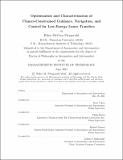Optimization and Characterization of Chance-Constrained Guidance, Navigation, and Control for Low-Energy Lunar Transfers
Author(s)
Fitzgerald, Riley McCrea
DownloadThesis PDF (17.26Mb)
Advisor
Cahoy, Kerri
Hattis, Philip
Linares, Richard
Terms of use
Metadata
Show full item recordAbstract
Low-energy transfers utilizing multi-body dynamics show great promise for future space exploration; in regions with multiple dominant gravitating bodies (for example, in the Earth-Moon system or among the gas giant moons) they can offer reduced capture Δv, more flexible launch windows, and an increased set of accessible arrival conditions to any spacecraft willing to deal with the extra transfer time they require. The reduced propellant utilization and increased flexibility make these transfers especially tempting for lunar missions with small satellites, which may have to deal with launch date uncertainty and may be unable to carry an engine large enough to achieve lunar orbit insertion via traditional means. As we seek to increase the utilization of lunar space in the coming years and decades, low-energy transfers will certainly prove to be a valuable tool.
Although these transfers have been well studied, the practicalities of navigating a spacecraft along them are often ignored. The long durations and unstable, non-linear dynamics of the problem allow small deviations from the nominal trajectory to grow considerably, and so a reliable strategy for orbit determination, navigation, and correction must be employed for any real flight along such a transfer. This is by no means impossible, and missions like Hiten and GRAIL have successfully flown to lunar orbit along low-energy trajectories. However, the standard method of correction is to employ large ground-based tracking resources like the Deep Space Network (DSN) at regular intervals along the transfer, and implement trajectory correction maneuvers at pre-planned times if needed. While this may be feasible for high-budget missions, the cost and operational burden that such a strategy imposes can make these transfers too expensive or impractical for resource-constrained missions.
This dissertation provides methods for reducing the cost that navigation and tracking impose on low-energy transfers, and for characterizing the cost and difficulty of transfer execution. First, a large and diverse catalog of transfers in the circular-restricted four-body problem is developed. Then, a general method for optimizing tracking and correction schedules is outlined; a genetic algorithm—making use of an efficient method for evaluating the probability of transfer mission success given a guidance, navigation, and control (GN&C) timetable—is used to minimize measurement cost subject to a constraint on the probability of transfer success. This method is then applied to all transfers in the catalog, in order to obtain minimum-cost DSN tracking and correction schedules for each trajectory. The results are analyzed using new metrics for transfer navigation feasibility and cost; these metrics predict when a given chance-constrained problem is infeasible, and provide rough predictions and upper bounds on the cost of navigation along feasible low-energy transfers. Finally, the optimization method is again applied to the catalog with the addition of on-board optical measurements in order to demonstrate the potential further cost savings enabled by the use of autonomous navigation. In summary, this work develops a practical method for designing efficient chance-constrained GN&C schedules for low-energy Earth-Moon transfers, and provides unique insights into the general structure of minimum-cost navigation and correction strategies along these trajectories.
Date issued
2021-06Department
Massachusetts Institute of Technology. Department of Aeronautics and AstronauticsPublisher
Massachusetts Institute of Technology